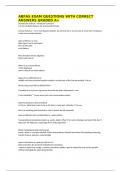Exam (elaborations)
ABFAS EXAM QUESTIONS WITH CORRECT ANSWERS GRADED A+
- Course
- Institution
ABFAS EXAM QUESTIONS WITH CORRECT ANSWERS GRADED A+ Diastasis for Lisfranc = a fracture is present 2-5 mm of diastis betwen 1st and second mt base Chronic lisfrancs--->ct=1 mm diastasis betwen 1st and 2nd mt or an increase of more than 15 degrees in the tarso-metatarsal joint signs of ...
[Show more]



